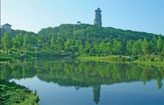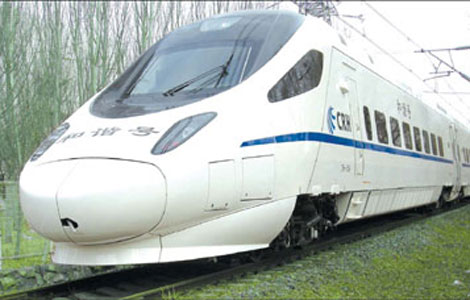China Face
Wife of famous architect preserves husband's legacy
Updated: 2011-04-20 21:07
(Xinhua)
BEIJING - Since his death some forty years ago, the birthday of Chinese architect Liang Sicheng has been celebrated with seminars on his theories and new books being published.
When he was alive, however, the "father of modern Chinese architecture" seldom celebrated his birthday, which fell on April 20.
"He joked that he refused to celebrate because the date was also the birthday of Nazi leader Adolf Hitler," recalled Lin Zhu, Liang's second wife, during an exclusive interview with Xinhua.
Wearing a green cardigan over a blue cheongsam, a lengthy traditional Chinese dress, she spoke slowly and with a low voice. The 83-year-old woman smiled tenderly when speaking about her late husband.
"Lotus flower out of water"
To many, Liang Sicheng is just a name from a history book or teleplay. To Lin Zhu, however, he is much more.
Liang's first wife was Lin Huiyin, a famous Chinese architect and writer who died in 1955. Seven years after her death, Liang married Lin Zhu, an assistant 27 years his junior.
"Many people asked me why I would marry him, because of our huge differences in age and life experience," she said.
Lin Zhu recalls that her early visits to Liang were out of courtesy.
"But later we began talking more, about everything from literature of the Soviet Union to our views on marriage," she said.
"It was amazing that there were no barriers and we felt safe telling each other our innermost thoughts and feelings. You know, to find such a good partner is extremely hard."
The architect was not only amiable, but also humorous, even when others made mistakes.
"Once I wrote a caption too close to a picture. He, our leader at the time, said, 'The reader will mistake the caption for crows on the roof.' While saying so, he winked at me and I didn't feel like I was being scolded," she said.
In his work, Liang became confident, persistent and, as Lin Zhu put it, "as pure as a child".
"He was influenced by his father Liang Qichao," Lin Zhu said.
Liang Qichao was a scholar best known for leading the Hundred Days' Reform during the Qing Dynasty (1644-1911). He dedicated a couplet to his second son, Liang Sicheng: "Lotus flower growing out of water doesn't need decoration/white seagull riding the wave with courage and determination."
During the Cultural Revolution, Liang Sicheng was criticized for his advocacy work in ancient city protection.
"In the hardest times, he said that he would rather die in his motherland than escape. Some people then believed him foolish, but I know he lived up to his father's instructions."
"He was with me almost everyday"
Lin Zhu didn't start her research into Liang's theories until his death in 1972.
"He was the author of China's first modern history on Chinese architecture, the Chinese representative on the board that designed the United Nations headquarters in New York, and designer of China's national emblem. His drafts are a great treasure for China's architecture," Lin Zhu said.
As an assistant only responsible for keeping data, her biggest challenge was that she did not understand Liang's works and notes.
When she was selecting pictures for a compilation on the history of Chinese sculpture, she found notes in his drafts that she didn't understand, like "O-xx pic."
She went to several libraries before asking a librarian at the Beijing University Library for help.
"It was so embarrassing. I was searching for a book but I had absolutely no idea of the name or its author. I just knew the first letter of author's name could be 'O,' and the book must be very thick due to number of the pictures."
An old librarian finally found the book. The author's name was Osvald Siren.
Lin Zhu commemorates her husband on each anniversary of his death.
"I was thinking of his contributions, and pondering over the differences between his theories and those of others. I ask myself questions and search for answers," she said.
This work helped her to better understand her husband.
"In this way, he has been with me almost every day," she said.
"My work hasn't finished"
Over fifty years ago, Liang Sicheng and the architect Chen Zhanxiang proposed a plan for Beijing's urban development. Their plan called for the preservation of the old city in its entirety and construction of a new city just west of it. Officials at that time, however, opted for another plan to build a new government and cultural center within Beijing's historical core.
Since then, many of the walled compounds holding Beijing's traditional residences, known as "Siheyuan", and "Hutong", the narrow alleys between those walled compounds or courtyard houses, have been leveled by bulldozers.
This has led to a series of problems, including heavy traffic congestion, that have sparked heated public complaints and led more and more people to feel nostalgic for Liang's defeated plan.
"Liang once compared the city of Beijing to a museum of China's feudal society, which reflected the politics, economy and culture of the old times," she said.
"But now, it is too late. The unique flavor of Beijing is lost," Lin Zhu said with a sigh
Despite her regret, she does not seem to have lost hope.
"Liang also said that we should shoulder the responsibility of preserving cultural heritage for both our ancestors and descendants. Now it is the turn of our descendants to do more."
When discussing her future work, Lin Zhu seems hesitant.
"I have finished sorting out his drafts, but he wrote many letters and notes in his early stages that I haven't gone through, " she said. "But I am so old."
Lin Zhu said she is in poor health and suffering from diabetes.
She raised her head, illuminated by the afternoon sun, to gaze at a small white statue of a Buddha that her husband brought back from a research project in a grotto in north China's Shanxi Province. A small black-and-white photo of her husband at work rests on the desk in front of her.
"My work hasn't finished," she said.
Specials

Models gear up car sales
Beauty helps steer buyers as market accelerates.

Urban breathing space
City park at heart of industrial hub positions itself as top tourism attraction

On a roll
Auto hub Changchun also sets its sight on taking lead in railway sector